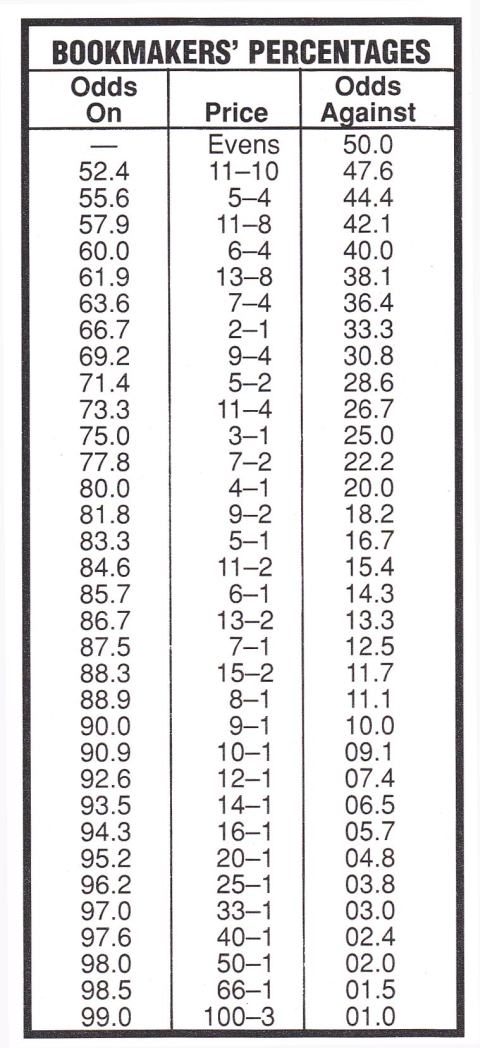Betting is all about percentages. A bookie makes a 'percentage book' and punters try to beat him.
The bookie, then, is much like the manager of a supermarket - he puts up prices which he hopes the public will 'buy', but, of course, no-one is forced to buy on a fielder's terms, especially if a quote about a selection is less than its true chance of winning.
Now, the betting percentage table there's one accompanying this article can be used in a host of ways. It enables you to interpret probability Let's assume you fancy Tulloch and he is quoted at evens. This is a 50 per cent or a one-in- two chance. If your form study has convinced you that the race has three chances (1-3) then, win or lose, evens is a BAD price. The lowest acceptable price about Tulloch should be 2-1 (33 per cent).
To assess the minimum (lowest) required price you should total up the number of true chances in a race, and deduct one. Let's say you work it out that there are four prospects. Four less one is three. So if the horses figure as having equal prospects, the shortest acceptable price is 3-1, which your percentage table shows as 25 per cent, or one winning chance in four.
If you're a punter who bets to flat stakes, you can also refer to the chart to work out how many winners you'll need to break even at price.
Example: If the average price of your winners is 6-4 the percentage chart shows that 6-4, is 40 per cent. To break even on level stakes would call for 40 winners per 100 bets. Any number below 40 would result in a loss.
The place punter can adopt a similar approach. You bet in level stakes and your average dividend is 70c for 50c, or odds of 2-5 (5-2 ON). The percentage chart shows this as 71 per cent, so to break even on your place betting it would be necessary to cash 71 per cent of your bets!
Let's look at another angle. The punter who wants to back two horses a race to profit by the same amount whichever wins, can lay out his stake in the same ratio as the percentages. Tulloch is, say, 21, Kingston Town 3-1 and Fine And Dandy 7-1. The percentage chart tells you to place 33 units on Tulloch, 25 units on Kingston Town and 12.5 units on the third horse. This is a total of 70.5 units. If one of them wins, you make 29.5 units profit.
Alternatively, you may favour a particular horse to win but want to insure (save) on another two you rate as the main dangers. Let's say you have an even your average winning money chance, a 4-1 and a 7-1. You fancy the 4-1 chance as the main bet.
Okay-you approach things this way. You have an even 50 on the hotpot, 12.5 on the 7-1 chance, making a total of 62.5 units. The balance, 37.5 units, you place on the 4-1 chance. A win by the evens chance or the 7-1 shot squares the bet. If your good thing wins at 4-1 you pick up 187.5 units, for a profit of 87.5 units.
Small punters can work the bet out in cents and then multiply by whatever unit level you wish. For instance, if the bank was $10 the multiplication would be by 1 Oc, calling for bets of $5, $1.25 and $3.75.
Experienced punters may find most of this pretty elementary but for the inexperienced it opens up new avenues of betting approach. Betting to percentages is a way of 'buying' a dollar for a small outlay. A professional punter usually thinks along the lines of buying a dollar for 75c. In other words, he'll bet 75c on a spread of horses in the hope of getting a return of $1 for each 75c outlaid-a 25 per cent return on his money.
Pittsburg Phil, the great U.S. punter, was one of the first men to seriously attack bookies with multiple betting. He aimed at earning a percentage of profit in relation to turnover. There are some critics of percentage betting who claim it doesn't help the small punter. Certainly, the person who bets $2 or $3 a week wants much better than a small percentage profit. But how many punters bet this small?
Even so-called small punters can actually turn over thousands of dollars in a year. If the average punter stops to think about how much he does invest, he'll be surprised at his profit potential. With re~ investments from winnings, he'll also be shocked at how much money he turns over.
Let's take the case of a punter whose bets average $50 a week. There will be occasions when he has a good win and can increase the size of his bets. At the end of a year, with his own cash and with re-investments, he will probably have staked around $6,000-and be losing! If he had gained a profit of only 10 per cent he would have won $600. A gain of 20 per cent would have earned him $1200.
So that's not worth worrying about? That potential $600 is a healthy sum, enough to give the family a happy Christmas. It's also the cost of a return fare to Hong Kong or Manila or Bali.
The object in betting is to make a profit and if it can be obtained through a percentage in relation to turnover, and with a degree of safety against the erosion of capital, then a punter, no matter how small, must last longer or finish in a better financial situation than the punter who goes for broke in a haphazard manner.
Study the percentages in racing, and you'll give yourself that vital edge. Ignore them and you give the other bloke-the bookie, and the TAB-the edge against you.
 By Statsman
By StatsmanPRACTICAL PUNTING - JUNE 1988